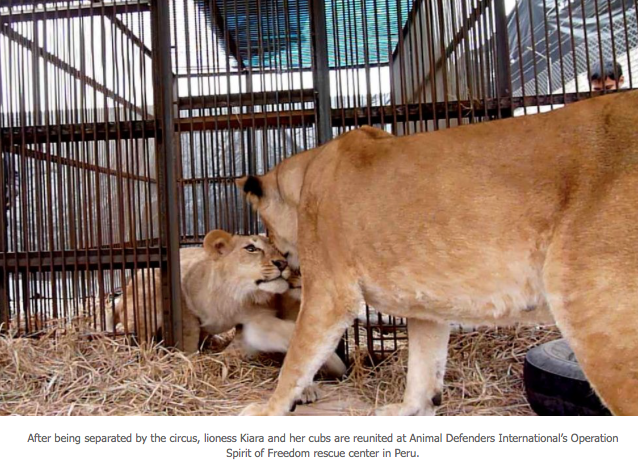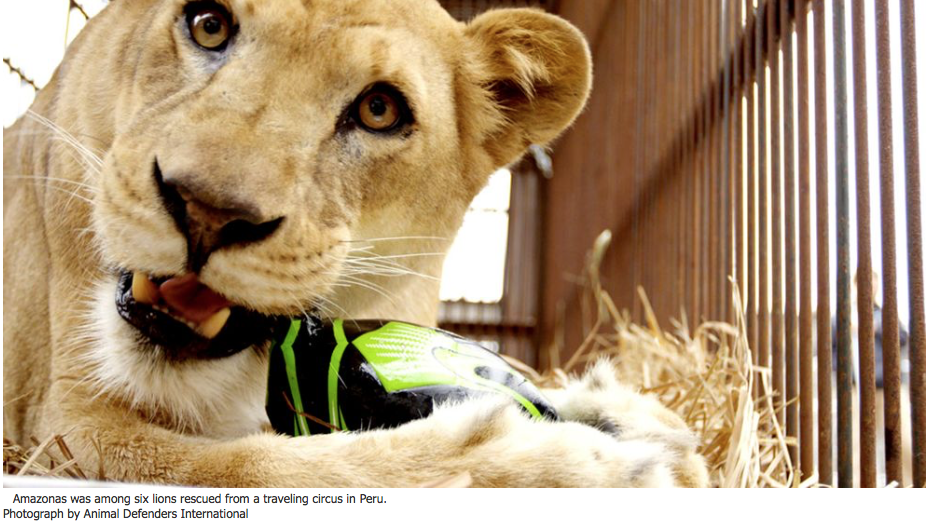National Geographic: Circus Lions Rescued in Peru, Headed for New Home in Colorado
Twenty-one circus lions and ten monkeys await transfer to a Colorado sanctuary early next year.

Photograph by Animal Defenders International
Laurel Neme for National Geographic
Published November 26, 2014
By early next year Jan Creamer, co-founder and president of Animal Defenders International (ADI), intends to see 30 lions rescued from circuses in Peru and Colombia running free in a permanent new home in Colorado.
London-based ADI, which is dedicated to stopping animal abuse and saving animals in distress, now has 21 African lions and ten monkeys in a temporary holding facility outside Lima.
The Peruvian animals will be joined by nine lions being held in a facility in Bucaramanga, Colombia. ADI took custody of the lions when a circus surrendered them voluntarily ahead of implementation of a ban on wild animals in circuses. All will be taken to the Wild Animal Sanctuary near Denver.
At ADI's urging, Peru and Colombia recently passed circus animal bans. Implementation is under way in Peru and will begin in Colombia next year.
Creamer and her international staff investigate animal abuse in circuses they suspect of cruelty or subpar conditions. They then publish their findings and push for regulatory change.
Since ADI's first circus undercover investigation, in 1992, the team has succeeded in getting nationwide bans on the circus use of certain species of wild animals in 27 countries, including Belgium, Colombia, India, and Taiwan.
They've achieved local bans in ten more countries, among them Australia, Chile, Spain, the United Kingdom, and the United States.
Creamer continues to advocate for additional regulatory bans, and in the coming months she intends to target more countries in Latin America, as well as the U.K. and the U.S.
Passage of these initiatives can take years. In the United States, Creamer says, ADI has been involved since 2011 in advancing and helping draft the proposed Traveling Exotic Animal Protection Act (TEAPA).
The act, which aims to amend the Animal Welfare Act, would restrict the use of wild animals in traveling circuses. ADI has provided scientific, legal, and empirical evidence to show the need for the bill and gathered support from members of Congress and the public. TEAPA will likely be reintroduced after Congress reconvenes in January.
Once a ban is in place, ADI helps governments implement the new law and solves problems, such as what to do with the mistreated animals.
Spirit of Freedom
ADI's rescue operation in Peru, called Operation Spirit of Freedom, is the second largest of its kind. The largest, Operation Lion Ark, also carried out by ADI, removed 29 lions and other animals from nine circuses in Bolivia in 2009, after animal acts were banned there.
In Peru, ADI tracked down four of the country's six traveling circuses: in Huaral, two hours outside Lima; in Ayacucho, a 19-hour journey across the Andes; in Cusco, 35 hours over the Andes; and near Arequipa, more than 24 hours from the capital by road. The remaining two are believed to have shut down.
ADI and Peruvian authorities raided the circuses, seized the animals, and transported them to the temporary holding facility.
In addition to the circus lions and a circus spider monkey, the ADI facility is caring for nine monkeys rescued from the illegal wildlife trade. Two tigers (believed to be hidden in a private home) and three lionesses, identified as belonging to circuses during ADI's investigation phase, have not yet been located.
Because the bans apply to the use of big cats in entertainment, and not their ownership, circus owners sometimes try to keep them. Peruvian authorities are trying to find the two tigers and three lionesses, and ADI has asked people to be alert to sightings.
In February 2015, ADI plans to transport the animals to the Colorado sanctuary, where they'll spend their final years. The delay allows time for ADI to obtain travel permits, do health checks, build crates, and get the animals fit for their 3,000-mile cargo flight.
None of the lions can be released into the wild. Not only have they spent their whole lives with humans, but they've been declawed, making it impossible for them to fend for themselves or catch prey. Many also have broken teeth from workers smashing them in the face to "discipline" them.
Speaking via Skype from the temporary holding facility outside Lima, Creamer explained how six performing lions were rescued from the Cusco circus: two adult males, Rey and Smith; two adult females, Amazonas and Kiara; and two 11-month-old cubs, Scarc (male) and Mahla (female).

What's the story behind the rescue of these lions?
Initially the owner refused to relinquish three of the six. While authorities negotiated their release, the circus continued its shows with Smith and the two cubs—with disastrous results. During one performance, Smith attacked a teacher [from the audience] and dragged her around the ring until the lion was beaten into submission. The teacher was uninjured.
What was the public reaction to this?
Following the incident, there was an initial outcry for Smith to be killed. But I pleaded for the lion's life ... and won. Once authorities understood why Smith attacked, they were happy to have me take him.
Why do you think Smith attacked?
The reason Smith attacked was mismanagement. He'd just been separated from his mate [Amazonas] and put in a cage with two cubs that were the offspring of a different male [Rey].
Smith had been attacking the cubs. He was already agitated. Then the trainer started the show and had the teacher stand in front of Smith while the lion was above her on a pedestal. The teacher then lowered her head. If the trainer had watched the lion's face, he'd have seen Smith focusing on the neck. But he was behind the lion. Then the trainer gave the command to jump.
Is that lack of understanding of the animals common in these circuses? And what are the ramifications of substandard conditions?
For many animals, being deprived of their mother too young causes behavioral and psychological problems. Being kept in barren, environmentally deprived conditions such as bare cages, bare boards, or being tied up or chained to the ground for the majority of their time causes the animals a level of distress that is often outwardly exhibited as repetitive behaviors such as rocking, swaying, pacing, self-holding, and other abnormal movements. These tell us the animal isn't coping well.
It's clear these animals suffer not only physical deprivation because they can't walk or run about but also mentally from their lack of ability to manipulate their environment, express curiosity, investigate—and all the other mental and emotional exercise they would find when living naturally.
How big is the problem of captive animals living in inhumane conditions?
Thousands of animals live in desperately deprived conditions around the world, and use of these animals in the entertainment industry—by circuses, for private functions, and for film and television—is a major problem.
In order to use animals to entertain people, the animals are taken away from their mothers at an early age and forced to do tricks by means of withdrawal of food and violence.
In different countries this can include beatings with whips, metal bars, kicking, and punching and use of electric shock devices. These animals are used like inanimate objects rather than living animals with the right to be protected from pain and suffering.
Because the driving force in the industry is that the animals make money, their needs are not given proper consideration, and there's little investment in facilities.

What is the result of these rescues?
The ability of ADI to solve the problem of what to do with the animals as a result of the new legislation is an important precedent for other countries. Quite rightly, when a government passes a law, they want to know how it will be implemented.
If it leaves them with animals remaining in circuses illegally, they need help to resolve that issue. We believe it's important to show governments that we're willing to help them and to help solve problems presented by new legislation.
How many animals has Animal Defenders International rescued?
We've lost count. Over the past 20 years, we've rescued hundreds of animals from different industries, including lions, tigers and other exotic cats; chimpanzees, monkeys, baboons, dogs, cats, and horses.
What first motivated you to do this work?
In the mid-1970s, someone gave me a leaflet in the street about beagle dogs being forced to smoke cigarettes in laboratory experiments. I joined the organization as a volunteer and then later felt that it was the most important thing I would ever do, so worked hard to get a full-time job doing what I love.
I'm still angered by cruelty and believe that the human race needs to radically change our relationship with the other species that share our planet. We now know more about the intelligence, communication, and emotions of other species—and need to learn how to respect those who don't look like us, or live like us, or communicate in ways we don't understand.
Your life has been threatened repeatedly, hasn't it?
Some circuses see that the world has changed and believe it's right to hand their animals over. But others don't. Animal users and abusers often threaten us—sometimes via messages through others.
I think some of these people are so used to being able to bully, they try to bully us too. But we cannot let them deter us. The animals only have us to help them, so we must step up and keep going to the end.
What was your scariest experience?
My scariest experience so far has to be traveling in a truck in convoy through the night on mountain roads in remote parts of Bolivia. We were on tiny roads in huge trucks loaded with lions. And we had to get them to the rescue center safely.
What is your most rewarding experience?
The best reward is always the same—the first time an animal gets hay, toys, and freedom to do as they wish in the rescue center and then the big reward: their first steps into freedom in their permanent home. Seeing animals run for the first time in their lives is amazing.

